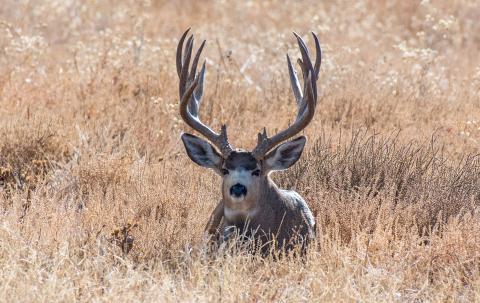Lindsay Thomas, Jr. | Originally published in GameKeepers: Farming for Wildlife Magazine. To subscribe, click here.
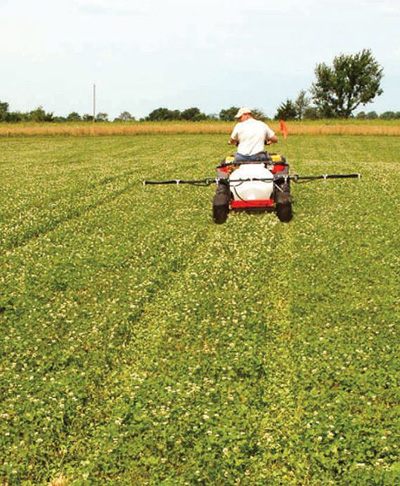
preparing the soil properly before you plant and
implementing a sound selective herbicide regime you can
compete with the grass and weeds from your native seed
bank and lead your clover stand into old age.
Many people plant clover plots, but few achieve the maximum potential lifespan of perennial forages. The following tips will help you guide even challenging clover food plots into old age.
Perennial clover plots are a lot like buck fawns: Without protection, few of them live to reach their full potential. As I have learned first-hand, just because perennial clover has the potential to live for five years or more, doesn’t mean this lifespan is automatic. Many factors that are within our control (like weeds and soil fertility) can bring an early death to a clover plot.
To learn how to achieve several years of strong clover production, I talked to Dr. Craig Harper, a professor of wildlife management at the University of Tennessee and an Extension wildlife specialist. Craig has planted food plots and hunted the deer that use them, but more importantly he has put food plots through university-level testing to produce valid results that meet scientific standards. His work is helping weed out a lot of faulty food plot lore.
Of course, your decisions during establishment affect your success at shepherding a stand of perennial clover into its “retirement years,” so this can’t be overlooked. If you plant a variety of clover in a soil type that doesn’t suit it, or a location that is too dry or too wet, no amount of maintenance will make it thrive. If you fail to look for and identify problem weeds on a particular site, and get them under control before you plant perennials, you are setting yourself up for a battle you won’t win. Weed control is inherently more difficult in perennial food plots than annual plots. The more you can do to control problem weeds before you plant perennials, the greater your chances of success.
Let’s assume you’ve already established a stand of perennial white clover (either the ladino or intermediate sub-type of white clover) and perhaps it is mixed with other perennials like chicory or alfalfa. What next?
Soil Fertility
Nutrient availability in the clover food plot’s soil will change throughout the life of the plot, and you should be ready to make amendments as needed. Craig said he typically pulls a new soil sample for testing every other year, but that’s on sites where he has experience and knows the usual pattern of nutrient loss. Until you gain that wisdom for a particular plot, soil tests are relatively cheap and should be conducted annually in spring or summer.
“If you bush hog a fallow field and disk in the debris, you incorporate a lot of nutrients, and they will slowly become available as the organic material decomposes over the next several months,” Craig said. “That will help sustain your forage plot for a while, but when nutrients from the organic material are used up, fertilization will be required. This doesn’t mean you can skip fertilizing your plots at planting time if you disk-in organic material, but it often explains the lush growth observed during the initial year of establishment followed by what can be relatively poor growth the second or third year.”
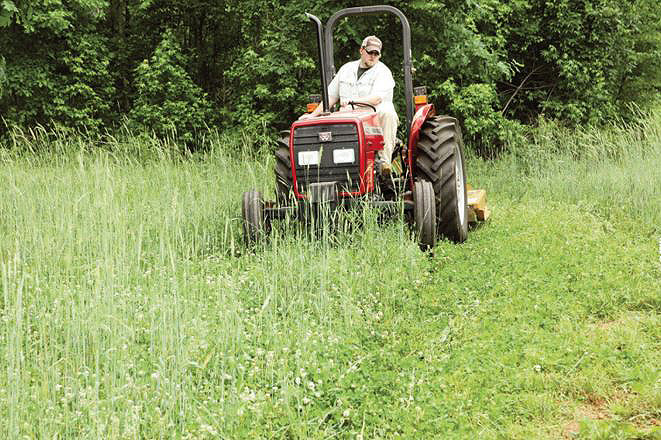
Craig said it is not uncommon for a soil test taken one year after establishment to call for the same amount of lime and fertilizer that was called for at planting. A test conducted two years after establishment may also call for significant amendment, but the appropriate nutrients should be getting up to sufficient levels by then. Nonetheless, adding lime and fertilizer should never be a guess: Follow the recommendations of your soil test and simply top-dress by spreading right on top of the standing crop.
“I like to top-dress in September here in Tennessee,” Craig said. “It’s just before growing conditions improve for perennial clovers, and there’s time for the nutrients to incorporate into the soil and become available to the plants before fall growth. In the North, I’d top-dress in August, and in the Deep South you could wait as late as early October.”
Another suggestion Craig offered is in cases where chicory is included in the plot. Chicory is not a legume, and it will benefit from a small shot of nitrogen (N) applied when growing conditions improve in the fall and again during late winter just as the weather begins to warm – about 30 lbs. of actual N/acre (for example, 65 pounds of 46-0-0 per acre). It’s often said that non-legumes benefit from the N produced by bacteria associated with clovers and other legumes. However, it’s not until the legume dies that the nitrogen produced in the nodules on the roots becomes available to other plants. This won’t become a source of N for non-legumes until much later in the life-cycle of the perennial plot.

Weed Control
No other factor brings an untimely end to as many perennial clover plots as weeds. This includes cool-season weeds (chickweed, henbit, speedwell, purple deadnettle, to name a few of the worst) and warm-season weeds (curly dock, horsenettle, marestail, thistle, and others). If only one group is controlled, or if either group is inadequately controlled, weeds will spread, steal nutrients and space from the clovers, and eventually overrun the plot. Post-emergence herbicide applications are necessary to control weed pressure and extend the life of perennial plots for several years.
“Anyone who wants to sustain a perennial forage food plot will have to manage weeds throughout the year,” Craig said. “The thing that escapes most people is that they have to spray both cool-season and warm-season weeds for year round weed control. They can’t just spray the plot one time and be done for the year. After those weeds die, others are going to germinate. Count on spraying once for warm-season weeds and once for cool-season weeds each year, and you might have to spray one or both of them twice, depending on the seed bank, if you wish to have ‘clean’ perennial plots.”
Despite what you may have heard, mowing does not get rid of weeds in perennial food plots. Grasses are not killed by mowing (think of your yard), nor are perennial broadleaf weeds (again, think of your yard). Some annual broadleaf weeds can be killed by mowing if they are mowed just after they flower, but all perennial forage plots will have perennial weeds.
Fortunately, there are some effective herbicides available to control most weed problems in perennial forage plots, and the choices and applications don’t have to be overly complicated.
- Grass-selective herbicides (kill grasses only) include clethodim (clethodim, Arrow 2EC, Select Max) and sethoxydim (Poast 1.5L, Arrest).
- Broadleaf-selective herbicides (kill forbs only) include 2,4-DB (Butyric 200).
- Broad-spectrum selective herbicides (kill some forbs and some grasses) include imazethapyr (Pursuit, Slay) and imazamox (Raptor).
“For the lion’s share of applications on weeds in perennial plots, these herbicides are all you need,” said Craig. “In most cases I will tank-mix 4 ounces of Pursuit per acre with 12 to 16 ounces of clethodim, depending on the species of grass I’m trying to kill, and a non-ionic surfactant, and I can keep my perennial plots relatively weed-free and productive.”
When to Spray Clover Food Plots
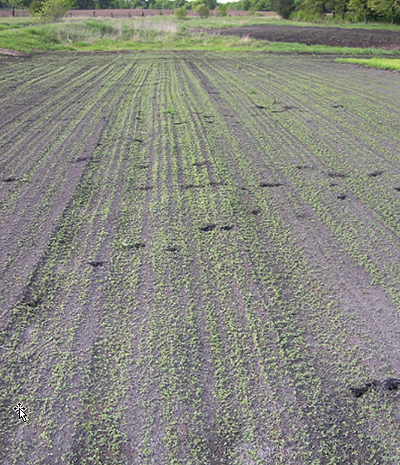
perennial stand. Along with ensuring the soil has a neutral
pH, you want to begin with a weed-free seedbed.
Plan on spraying warm-season weeds the first time in April (South) or May (North).
“After some time and a few rain events, you may need to spray a new flush of warm-season weeds,” said Craig. “If they’re widespread throughout the plot, spray the whole plot again, but if they are scattered, you can spot-spray with a hand-held or backpack sprayer. I often use glyphosate with a handheld or backpack sprayer and apply a very low volume precisely to individual weeds and do my best to avoid killing the surrounding desirable forages.”
Spraying cool-season weeds usually needs to happen in fall or winter, depending on the stage of growth of weeds, amount of rainfall, and other factors.
The key to effective weed control in all seasons is spraying at the correct time and monitoring the plot closely. If you stay on top of weeds and use effective control measures before new seeds are produced, you will gradually reduce the weed seed bank in the plot, and weed control will become easier over time. Just be sure not to bring new weed seeds back into the field on equipment, like your mower.
“Oh my gosh, how many food plots I’ve contaminated by bringing weed seed in from somewhere else! Not only did I bring it in, I have paid to bring it in,” said Craig. “In the early 1980s, I had a buddy who owned a dairy and he would bring in a dump truck load of manure to ‘sweeten’ a plot of alfalfa, and ever since that day we have had curly dock in that plot, and it is tough to get rid of. If you don’t live on the site, or visit it often so you can stay on top of it, you will never get rid of curly dock.”
Incidentally, I asked Craig about spraying perennial clover with Roundup, a practice that some food plot managers say can work for weed control without killing the clover if you spray at the exact right time. Craig said he has used this technique when clovers are wilted during oppressive summer heat, but this is not a cure-all and it is not something he widely recommends.
“When perennial forages shut down because of overly hot, dry conditions, many weeds are also stressed. Post-emergence herbicide applications are most successful when plants are actively photosynthesizing and growing. Spraying the appropriate herbicides when weeds are young and actively growing is a much more successful strategy.”
When perennial plots are badly stressed during hot summer weather, it is a good time to mow if you have weed pressure.
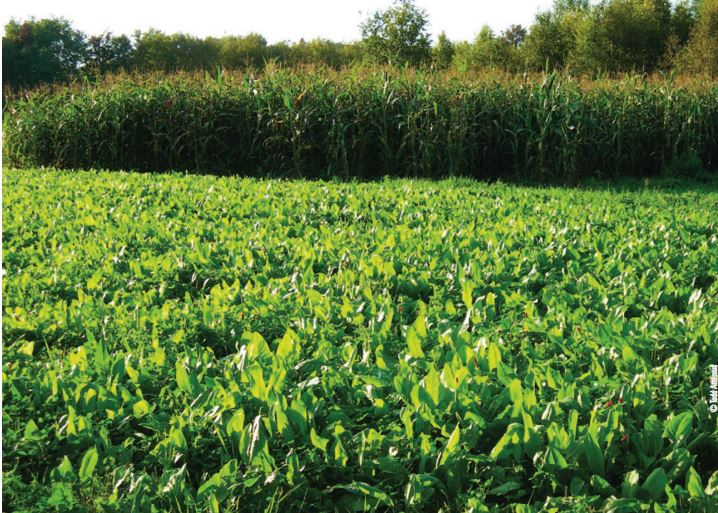
About Mowing
Craig Harper was the first habitat management expert I ever heard begging hunters to leave the Bush-hog in the shed. More good wildlife habitat is destroyed by indiscriminate mowing, he said, than most hunters realize. Neither does he believe that mowing is a primary technique for managing clover food plots.
“Mowing definitely has a place in your perennial food plots, but you can save yourself a lot of time mowing if you spray the correct herbicide at the correct time,” he said. “You can spend a lot of time mowing and still have lots of weeds, or you can spray about twice per year and mow once and have much better results.”
“With the exception of mowing weeds that have gotten too mature to be susceptible to herbicide, I only mow my perennial plots once a year, and that’s generally in August. It’s the end of the growing cycle, the clover and chicory have flowered and produced seed, and most people would say the plot looks ragged. I’m mowing a few scattered weeds, a little bit of clover, and chicory bolts. The production period of the plot is over. I’m getting it prepared for fall growth. Come October, it will look great.”
Craig notes the management timing and forage production period is different in the north where perennial clovers act realistically as a warm-season crop, producing throughout summer.
This advice on mowing differs from some food plotters, who believe in mowing clover when it is at its most productive.
“It’s a myth that you have to mow in order to have a nutritious clover plot,” said Craig. “That’s just wrong. If the clover is doing well in May and June and deer are eating it, let them eat it. Don’t mow it! The nutritive value of a perennial clover leaf that is 4 weeks old compared to one that is 8 weeks old during this time is negligible for white-tailed deer. You worked hard to produce 4,000 pounds per acre of high-quality clover and chicory. Why wake up one Saturday morning in June and mow down three-quarters of it? It doesn’t make sense! Wait until after the forages produce seed before you mow. Unfortunately, many people mow because they want to get outside and do something to manage the land. If they would redirect their effort to other management activities, they would be much more successful in reaching their habitat management objectives for deer.”
Craig’s once-a-year mowing often takes place the same time he needs to top-dress the plot, so both tasks can be tackled in one visit.
Insects, Diseases, & Bald Spots
Throughout the life of your perennial plot, you will spend much of your time concerned with weeds. But other issues may arise. Insects, diseases, funguses and molds are generally not common problems in clover stands. If you planted a blend of clover and alfalfa, you will likely see alfalfa weevils each spring, and there are insecticides you can spray to control them.
“The most common insect problem with clovers is grubs,” said Craig. “When you have grubs, you’ll know it because you’ll see where skunks have dug little holes all over the food plot. You can also spray an insecticide to control grubs.” Various molds, mildews and funguses may appear, sometimes causing minor bald spots in your stand. If you didn’t mow the clover before it produced seed, the seed would naturally fill those bald spots eventually.
“When a clover plot wilts down during summer, it looks rough,” Craig said. “That’s also when you might see bald patches. But come fall, if you’ve allowed those areas to reseed themselves naturally, those areas will fill back in.”
If you fear seed may be limited, you can top-sow those areas in August or September. But be ready to control weeds. They will also try to claim the bald patches. “Not that many people have to worry about molds or insects,” said Craig, “but everyone will have to control weeds.”
When to Pull the Plug
Even with careful maintenance, no clover plot can thrive forever. When is it time to rotate to a new crop? “What you will see over time is a general fading of your clover or chicory,” said Craig. “The stand becomes less and less dense, and you’re seeing more bare ground. That’s usually by year five, but it might be longer. Driving a clover plot into year three is no problem. Past year five is more difficult. That’s when the crop is more susceptible to molds, mildews and other problems. It’s time for crop rotation. Of course, most perennial forage plots never see year five because they are overtaken by weeds long before then. If you don’t control weeds, don’t worry about year five.”
Craig recommends giving every plot at least one year off from perennial clovers when it’s time to renovate. Disk the plot, plant a warm-season annual such as soybeans, cowpeas or lab-lab, and then follow that with a cool-season annual such as wheat or oats. The next year, you’ll be ready to rotate back to clover if you want.
Listening to Craig Harper talk about deer habitat can be a bit like drinking from a fire hose. He is one of the most knowledgeable experts on managing food plots and natural forages.
Lindsay Thomas Jr. is QDMA’s Director of Communications and editor of Quality Whitetails magazine. He was co-editor of QDMA’s book, Quality Food Plots. Follow Lindsay on @LindsayThomasJr.

















